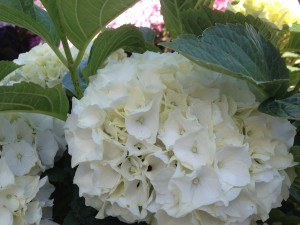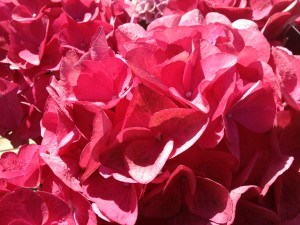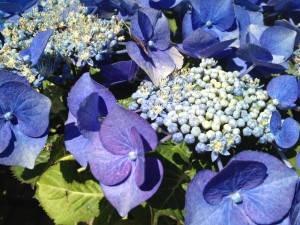Hydrangea macrophylla: the mophead hydrangea, bigleaf hydrangea and lacecap hydrangea
Hydrangea macrophylla has large round flowerheads called mopheads or round, flat umbels called lacecaps. This species mainly grows in gardens. The flower buds usually emerge from wood that is two or several years old.
It is an easy, deciduous shrub, which blooms in late summer in different colours such as white, red, pink, deep pink, blue and purple. The plant is very hardy and its flowers are mostly spherical, although some species produce flat lacecaps. Hydrangea macrophylla prefers partial shade and soil that is not too dry.
These hydrangeas have large leaves with big surface areas, so they require ample irrigation. They do especially well in partial shade with some morning or evening sun, no midday sun and in filtered sunlight under a canopy that lets through some fine rays of light. Deep shade has a negative effect on their flower formation and will make the plant droop and fall open.
Hydrangea macrophylla Endless Summer, Forever & Ever, Magical, Music Collection offer several advantages. Unlike the ordinary Hydrangea macrophylla, they have a very long flowering period and they are also easy to prune.
Pruning
Leave the old flowers alone during the winter months, as they will protect the tender growth buds underneath from frost and cold wind.
Hydrangea macrophylla has two types of flowers: normal spherical flowers called mopheads and ‘Teller’ type flowers with flat umbels called lacecaps. The latter group requires little or no pruning. Only the weaker and dead branches should be cut. The mophead species call for a little more precision if we want to enjoy new flowers every year.
Last year’s spent flowers need to be deadheaded: cut back the stem of dead flower heads to the first strong, healthy bloom buds down from the faded bloom. The bloom buds are a thicker pair of flower buds on either side of the stem. Make sure not to prune any one-year branches, as they will most certainly have bloom buds on the head of the stem.
You can give the hydrangea macrophylla a good prune for a better bloom. Mophead hydrangeas start growing new bloom buds in late summer. If you were to cut back all the branches in spring, the plant will not have any flowers that summer. Still, it is advisable to rejuvenate adult mophead hydrangeas regularly.
Cut back about one third of the oldest, thickest stems to 5-10 cm from the surface. This type of pruning encourages the production of new replacement growth and ensures the flower size remains the same.
During pruning, you can already see the thick bloom buds from which future flowers will appear.
If an established hydrangea macrophylla has simply grown too large, you can hard prune it by cutting back all branches to 20-30 cm from the surface in spring. You should water the plant generously and add some compost or new garden soil. After this type of pruning, the hydrangea will produce new growth again, but not produce any new flowers until the following year.
When planting hydrangeas, always leave a 75 cm distance between plants.
Why are my blue hydrangea blooms turning pink?
A blue flowering hydrangea needs acidic soil to keep the flowers’ intense blue colour.
How can you make the soil more acidic?
A fair amount of black peat will make the soil more acidic, so make sure to add a lot of black peat to the plant hole when planting your blue hydrangea.
White mopheads are not affected by acidic or calcareous soil and not all pink hydrangeas will change colour in the same way. After treating the soil with black peat, pale pink mopheads will generally turn light blue.
There are two important conditions for beautiful blue hydrangeas:
- The plant should be in acidic soil with a PH between 4 and 5.5.
- The soil must contain enough iron or aluminium. Also bear in mind that in calcareous soil, calcium and iron combine, so the iron will no longer be available to the plant.
Use acidic soil for planting and give the plant a dose of aluminium sulphate (alum) in late August and mid-March. You can dissolve aluminium sulphate in water or simply scatter it around the plant. Our range also includes a special soil improver for rhododendrons and hydrangeas.
Hydrangea macrophylla – Hydrangea/Big leaf hydrangea
- Position: full sun/partial shade
- Soil: moist/well drained soil
- Flowering period: July – September
- Height: 1-2 m
- Evergreen: no
- Hardy: yes










